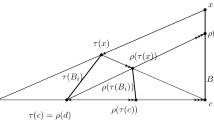Abstract
We classify embeddings (i.e., “labeled drawings”) of the Pappus configuration in projective planes over commutative fields, up to projective equivalence. Using pairs of field elements, we parameterize the space of classes of projectively equivalent embeddings, and then explicitly determine the group of ambient automorphisms (or dualities) for any given parameter pair, i.e., the subgroup of the group of all automorphisms (and dualities) of the abstract configuration that are induced by projective collineations (or dualities) leaving invariant the image under any embedding in the given class. It turns out that the existence of an ambient duality implies an ambient polarity. We show that these parameter pairs can be interpreted as pairs of cross ratios associated in a rather natural way with the embedded configuration. The number of equivalence classes of embeddings in a projective plane over a given finite field is determined. The groups that occur as full ambient groups are identified in the subgroup lattice of the full automorphism group of the abstract configuration. Finally, we use our results to understand embeddings of the Möbius–Kantor configuration.










Similar content being viewed by others
Notes
In the German original ([10, p. 117]): “[...] so können wir sagen, daß der Satz von Pascal der einzig wesentliche Schnittpunktsatz der Ebene ist, daß also die Konfiguration \((9_3)_1\) die wichtigste Figur der ebenen Geometrie darstellt”.
For embeddings into \(\mathbb {P}_{2}(\mathbb {R})\) or \(\mathbb {P}_{2}(\mathbb {C})\), this has been observed already by Levi [16, pp. 116], see also [5, p. 276]. For embeddings into \(\mathbb {P}_{2}(\mathbb {R})\) such that no triad is collinear and no parallel class is confluent, Kommerell [14, p. 32] reports that he has not found any ambient automorphisms apart from those in \(\langle \tau \rangle \).
The authors are grateful to Peter Müller at Würzburg for providing this example plus the theory necessary to understand it in context.
The action of \(\overline{\Gamma }/\mathrm {Z}\) on \(\mathbb {A}_{2}(\mathbb {F}_3)\) may be helpful here, see 5.7.
See https://archive.org/details/pappialexandrin01hultgoog/page/n409
(accessed on October 15, 2019).
References
Baer, R.: Linear Algebra and Projective Geometry. Academic Press Inc., New York (1952)
Bohne, E., Möller, R.: Über die Anzahl projektiver Pappos-Konfigurationen in endlichen Desarguesschen affinen Inzidenzebenen. Beiträge Algebra Geom. 17, 23–30 (1984)
Coxeter, H.S.M.: Self-dual configurations and regular graphs. Bull. Am. Math. Soc. 56, 413–455 (1950)
Coxeter, H.S.M.: The Pappus configuration and the self-inscribed octagon. I. Indag. Math. 39, 256–269 (1977)
Coxeter, H.S.M.: The Pappus configuration and the self-inscribed octagon. II. Indag. Math. 39, 270–284 (1977)
Coxeter, H.S.M.: The Pappus configuration and the self-inscribed octagon. III. Indag. Math. 39, 285–300 (1977)
Dugas, M., Göbel, R.: Automorphism groups of fields. Manuscr. Math. 85, 227–242 (1994)
Frobenius, F.G.: Ueber die Congruenz nach einem aus zwei endlichen Gruppen gebildeten Doppelmodul. J. Reine Angew. Math. 101, 273–299 (1887)
Grundhöfer, T., Stroppel, M.J., Van Maldeghem, H.: Embeddings ofhermitian unitals into pappian projective planes. Aequ. Math. 93, 927–953 (2019)
Hilbert, D., Cohn-Vossen, S.: Anschauliche Geometrie, 1st edn. Springer, Berlin (1932)
Hilbert, D., Cohn-Vossen, S.: Geometry and the Imagination. Chelsea Publishing Company, New York (Translated by P. Neményi) (1952)
Kantor, S.: Ueber die Configurationen \((3, 3)\) mit den Indices \(8, 9\) und ihren Zusammenhang mit den Curven dritter Ordnung. Akad. Wiss. Wien, Math.-Natur. Kl. Sitzungsber. IIa 84 (1881), 915–932
Knarr, N., Stroppel, B., Stroppel, M.J.: Desargues configurations: minors and ambient automorphisms. J. Geom. 107, 357–378 (2016)
Kommerell, K.: Die Pascalsche Konfiguration \(9_3\). Deutsch. Math. 6, 16–32 (1941)
Lenz, H.: Vorlesungen über projektive Geometrie. Mathematik und ihre Anwendungen in Physik und Technik, Reihe A, Band 30. Akademische Verlagsgesellschaft Geest & Portig K.-G., Leipzig (1965)
Levi, F.W.: Geometrische Konfigurationen. Mit einer Einführung in die kombinatorische Flächentopologie. S. Hirzel, Leipzig (1929)
Mielants, W.: Pappus-Pascal configurations in Pascalian projective planes. In: Atti del Convegno di Geometria Combinatoria e sue Applicazioni (Univ. Perugia, Perugia, 1970), Ist. Mat., Univ. Perugia, Perugia, pp. 339–350 (1971)
Möbius, A.F.: Kann von zwei dreiseitigen Pyramiden eine jede in Bezug auf die andere um- und eingeschrieben zugleich heißen? J. Reine Angew. Math. 3, 273–278 (1828)
Neumann, P.M.: A lemma that is not Burnside’s. Math. Sci. 4, 133–141 (1979)
Pappus: Pappi Alexandrini collectionis quae supersunt, ed. Friedrich Otto Hultsch, vol. 2. Apud Weidmannos (1877)
Pappus of Alexandria: Book 7 of the Collection, vol. 8 of Sources in the History of Mathematics and Physical Sciences. Springer, New York (Part 1. Introduction, text, and translation, Part 2. Commentary, index, and figures, Edited and with translation and commentary by Alexander Jones) (1986)
Pickert, G.: Projektive Ebenen, vol. LXXX ofDie Grundlehren der mathematischen Wissenschaften in Einzeldarstellungen mit besonderer Berücksichtigung der Anwendungsgebiete. Springer, Berlin (1955)
Samuel, P.: Projective geometry. Undergraduate Texts in Mathematics. Springer-Verlag, New York (Translated from the French by Silvio Levy, Readings in Mathematics) (1988)
Schmelzer, M.: Automorphismen von Körpern und Strukturen. Results Math. 25, 357–369 (1994)
Schönflies, A.M.: Ueber die regelmässigen Configurationen \(n^3\). Math. Ann. 31, 43–69 (1888)
Stroppel, M.J.: Generalizing the Pappus and Reye configurations. Aust. J. Combin. 72, 249–272 (2018)
Author information
Authors and Affiliations
Corresponding author
Additional information
Publisher's Note
Springer Nature remains neutral with regard to jurisdictional claims in published maps and institutional affiliations.
Rights and permissions
About this article
Cite this article
Knarr, N., Stroppel, M.J. Embeddings and Ambient Automorphisms of the Pappus Configuration. Results Math 74, 196 (2019). https://doi.org/10.1007/s00025-019-1115-7
Received:
Accepted:
Published:
DOI: https://doi.org/10.1007/s00025-019-1115-7




